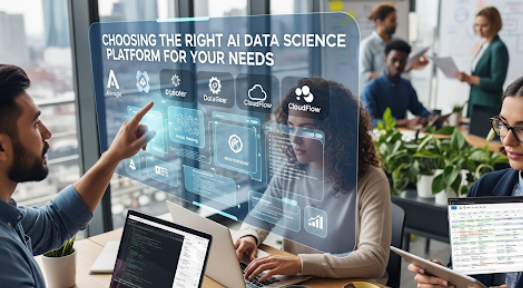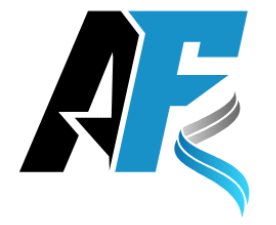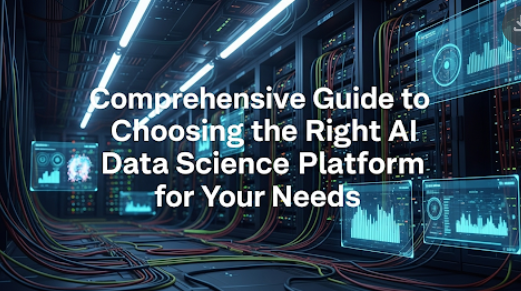Choosing the Right AI Data Science Platform for Your Needs
It may seem daunting to find the perfect AI data science platform. When there are dozens out there, and each one is promising to do wonders turning your data into insights, which one should you choose? Our guide breaks it all down so you can make an educated decision that suits your particular needs and budget.
Why It’s Worth More Than Just Your Time to Invest in an AI Data Science Platform
The best way to define it is that an AI data science platform represents your studio, only digital. Like a Swiss Army knife for data professionals, if you will. These platforms take care of everything, like cleaning data, visualizing it and making complicated machine learning models.
All of the best will have one master tool that eliminates an assortment of stand-alone platforms you are using. No switching between different software for data preparation, analytics, and model deployment; You have everything in the same place. This streamlining enables time-saving, prevents errors and simplifies collaboration.
The democratization of advanced analytics is another key feature modern data science platforms offer. These methods are also very user friendly — you do not have to be a statistician with a PhD or anything like that. That should be good enough for most; many provide drag-and-drop interfaces, some offer pre-built templates and automated features to help users through complex processes.
Key Features That Actually Matter
Data Integration and Management Capabilities
A good platform should seamlessly connect to your existing data sources. Look for platforms that support:
- Range of data formats: CSV files, databases, cloud storage, APIs and streaming data
- Real-time data processing: Required by companies that require the most recent results
- Data quality tools: Discover missing values, duplicates, inconsistencies automatically
- Version control: Track changes to datasets and models over time
- Scalability: Should be able to cater to small data sets and big data environments
Machine Learning and AI Tools
Not all platforms offer complete machine learning abilities. Essential features include:
- Pre-defined algorithms: Well-known models, for example linear regression, decision trees or neural networks
- AutoML features: Model selection and hyperparameter tuning automatically
- Custom model support: Allows you to import your own algorithms
- Model validation: Cross-validation, performance metrics and testing frameworks
- Advanced capabilities: Deep learning, NLP and computer vision functionality
Visualization and Reporting Options
Data storytelling is really important to communicate findings to stakeholders. Look for platforms with:
- Interactive visualizations: Charts that are real-time and update dynamically
- Custom reports: Pre-built templates that you can edit to reflect your brand and needs
- Export features: Users can export the visualizations as PDFs, images, or web links
- Mobile compatibility: Dashboards that display clearly on mobile devices, such as smartphones and tablets
- Insight discovery: Being able to easily see insights within dense datasets
Collaboration and Workflow Management
Modern data science is a team sport. Your platform should support:
- Access controls: Project permissions (determine who can view, edit or delete projects)
- Version control: Managing readable history and rollbacks as needed
- Communication tools: Comments and notes so team members can communicate about discoveries right inside projects
- Automated workflows: Configure solutions for processing tasks at required intervals
Top Platform Categories and Their Sweet Spot
Cloud-Based Solutions
Examples: Amazon SageMaker, Google Cloud AI Platform, Microsoft Azure Machine Learning
Ideal Use Case: Companies that want scalability while avoiding infrastructure management
Cloud platforms provide limitless computing power and storage. You pay for what you use, which makes them affordable for projects with variable workloads. They integrate with other cloud services and are updated automatically.
Pros:
- No hardware maintenance required
- Vertical scaling in/out based on usage
- Built-in security and compliance features
- Global accessibility from any location
Cons:
- Costs can accumulate with ongoing subscription fees
- Requires reliable internet connection
- Data location & security compliance is harder to control
- Potential vendor lock-in concerns
Enterprise On-Premise Solutions
Examples: SAS, IBM SPSS, Palantir Foundry
Ideal Use Case: Large organizations with very strict data governance
On-premise solutions allow you to manage your data as well as the infrastructure. Perfect for industries that have stringent regulations such as healthcare, finance and government.
Pros:
- Data security and location are entirely under your control
- One-time purchase with no ongoing subscription fees
- High degree of customization tailored to individual needs
- Works without internet connectivity
Cons:
- Significant upfront investment in hardware and software
- Requires dedicated IT staff for maintenance
- Limited scalability without additional investment
- Becomes outdated with fewer updates and new features
Open-Source Platforms
Examples: Apache Spark, TensorFlow, R + Python & Jupyter Notebooks
Ideal Use Cases: Startups, research institutions and organizations with technical know-how
Open-source platforms offer the most flexibility and can be customized the most. They are free to use but need more technical knowledge to make them work and keep them updated.
Pros:
- No licensing costs
- Complete customization freedom
- Large community support and resources
- Access to cutting-edge features first
Cons:
- Requires significant technical expertise
- No official customer support
- Time-consuming setup and maintenance
- Security responsibility falls on your team
Hybrid Solutions
Examples: Databricks, Snowflake, DataRobot
Ideal Use Case: Companies that want the benefits of cloud but need on-premise control requirements
Hybrid combines the best elements of each approach. They provide the ability to scale in the cloud but ensure your sensitive data remains on-premise when required.
Top Platforms Side-By-Side
| Feature | Cloud Platforms | Enterprise On-Premise | Open Source | Hybrid |
|---|---|---|---|---|
| Setup Time | Hours | Weeks to Months | Days to Weeks | Days |
| Cost Structure | Subscription | High Upfront | Free (Labor Costs) | Mixed |
| Scalability | Excellent | Limited | Manual | Excellent |
| Customization | Limited | High | Maximum | High |
| Support | Professional | Professional | Community | Professional |
| Security Control | Shared | Full | Full | Flexible |
Choosing the Best Choice for Your Business
Assess Your Technical Resources
Be realistic about your team’s skill set. Do you already have data scientists and IT pros with experience? Or do you want a tool that a business analyst could use after some minimal training?
- High technical expertise: Open source or highly customizable enterprise solutions work best
- Moderate technical ability: Hybrid platforms or cloud solutions that are more user-friendly with easier interfaces
- Low technical ability: Cloud platforms with very strong AutoML features and comprehensive customer service
Budget Considerations Beyond Sticker Price
Don’t look at only the cost of the platform. Consider Total Cost of Ownership:
- Software licensing or subscription fees
- Hardware costs (for on-premise solutions)
- Implementation and setup expenses
- Training costs for your team
- Ongoing maintenance and support
- Integration costs with existing systems
A more expensive platform may well be a bargain over the long term if it requires less implementation time and training.
Scalability Planning
Think about how your organization will look in 2–3 years:
- Is the volume of data you handle going to grow?
- Do you require more complex AI capabilities?
- How many users will require access to the platform?
- What are some new data sources you could integrate?
When evaluating potential platforms, ensure you can scale rather than quickly reaching the upper limits of your options.
Security and Compliance Requirements
The requirements around how to protect data will vary depending on industry:
- Healthcare: HIPAA compliance for patient data privacy
- Finance: SOX compliance for financial reporting
- Retail: PCI DSS to secure payment card information
- Government: FedRAMP authorization for US government standards compliance
Confirm that the platform you choose complies with regulatory requirements within your industry and geographic markets.

Step-by-Step Implementation Guide
Phase 1: Beginning a Pilot Project (Weeks 1–4)
- Choose a small and specific use case for testing
- Select 2-3 platforms based on your needs
- Create test accounts or request demos from vendors
- Upload sample data and validate basic features
- Evaluate ease of use and feature completeness
Phase 2: Team Training and Assessment (Weeks 5–8)
- Train primary team members on each platform
- Run pilot projects on each platform
- Compare results by accuracy, speed and ease of use
- Collect feedback from all types of users
- Evaluate compatibility with other workflows and tools
Phase 3: Decision & Roll Out (Weeks 9–12)
- Select the final platform after all experiments have been conducted
- Finalize contracts and pricing with your vendor of choice
- Begin full implementation with data migration
- Create training courses for all users
- Establish governance policies for platform usage
Common Mistakes to Avoid
Choosing Based on Features Alone
More features doesn’t mean better value. Focus on what you will actually use instead of long lists of extended capabilities. You can do more with a platform that is simpler and meets your basic needs than with a feature-filled, bloated platform that’s difficult to use.
Ignoring Change Management
The best system in the world does no good if your team won’t use it. Get key users involved in the selection process and prepare for training. Consider the learning curve and choose platforms that meet your team where they are with technology adoption.
Underestimating Integration Challenges
Your data science platform should integrate well with your current tools and data sources. Check integration capabilities deeply during the evaluation phase. Consider both technical integration needs and workflow compatibility.
Focusing Only on Current Needs
Although you need to solve today’s problems, think about tomorrow’s requirements. Pick a platform that can grow with your organization’s data science maturity and changing business needs.
Future-Proofing Your Investment
Things move fast in data science. Look for platforms that show they are invested in innovation:
- Regular updates and new capability releases
- Vibrant user communities & third-party ecosystem development
- Investment in emerging technologies such as quantum computing and edge AI
- Clear product roadmaps aligned with industry standards
You’ll also want to look at the financial stability and market presence of the vendor. Selecting a platform from a company that may go out of business introduces unnecessary risk.
Frequently Asked Questions
Q: What should I expect to pay for a data science platform?
A: This depends heavily on your needs. Cloud platforms can run from $100-1000+ per user per month. Enterprise on-premise software requires $50,000-500,000+ initial setup plus annual maintenance fees. Open-source platforms are free but require significant time investment to make production-ready.
Q: What if I need to change platforms down the road?
A: Yes, but it would be a costly effort to switch platforms. Select a platform that is suitable for the long run by taking time to choose carefully. Fortunately, nearly all platforms support data export, but you will need to rebuild your models and retrain users on the new platform.
Q: Do I need to be a data scientist to use these platforms?
A: It depends on the platform and what you’re using it for. Many modern platforms provide user-friendly interfaces and AutoML capabilities that can be used effectively by non-technical business analysts. However, more complex projects and custom models generally need someone with data science expertise.
Q: How important is customer support for a platform?
A: Extremely important, especially during implementation and the first year of use. Look for vendors that provide comprehensive documentation, training materials and have responsive support teams. Check what support channels are available (chat, phone, email) and their promised response times.
Q: Should I choose a specialized platform or general-purpose platform?
A: General-purpose platforms work best for most organizations because they cover a wider set of use cases and provide better return on investment. Consider specialized platforms only if you have very niche requirements that general-purpose platforms cannot effectively meet.
Making Your Final Decision
Choosing the right AI data science platform requires balancing factors such as cost, functionality, ease of use and future scalability. Your organization’s ideal platform is one that:
- Addresses your most important data science challenges effectively
- Fits within your budget and technical capabilities
- Can scale with your needs and growth over time
- Integrates well with your existing tools and workflows
- Has strong vendor support and development roadmap
Take the time to do a complete evaluation of your options with hands-on testing and real demos. Your investment in proper evaluation will pay dividends through smooth implementation and a successful long-term relationship with the platform that suits your needs.
Keep in mind that you don’t need the ultimate platform — rather, you need the right platform for your unique needs and circumstances. With the right evaluation and planning, you can choose a data science platform that will serve as a solid foundation for your organization’s data-driven decision making now and in the future.

